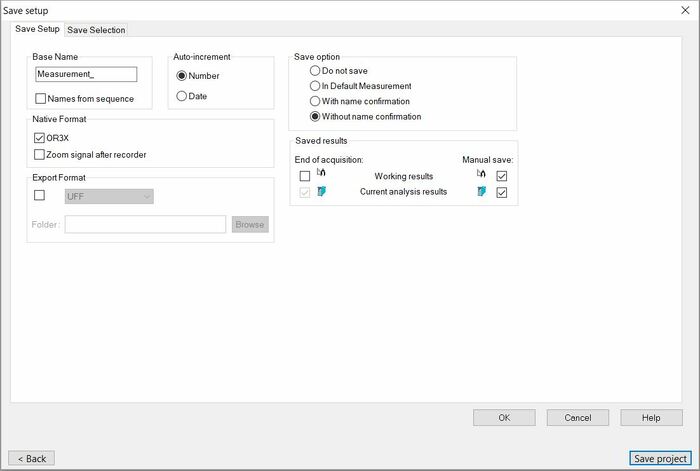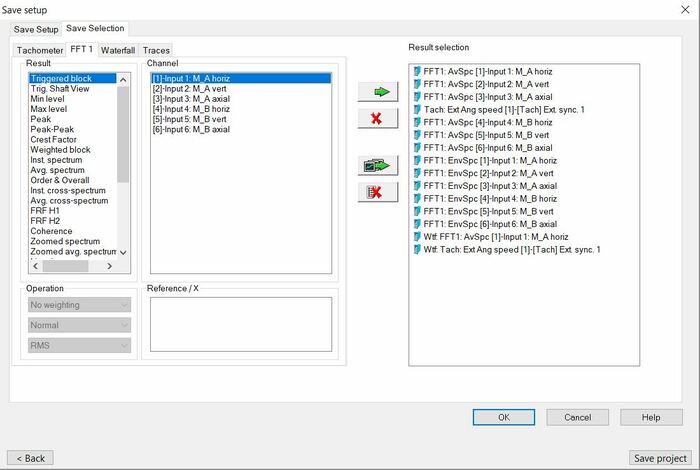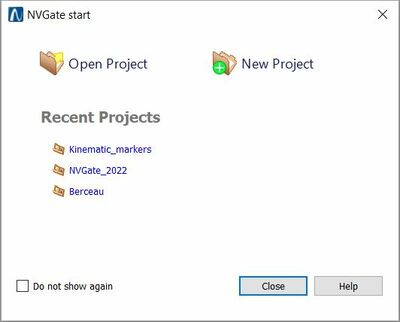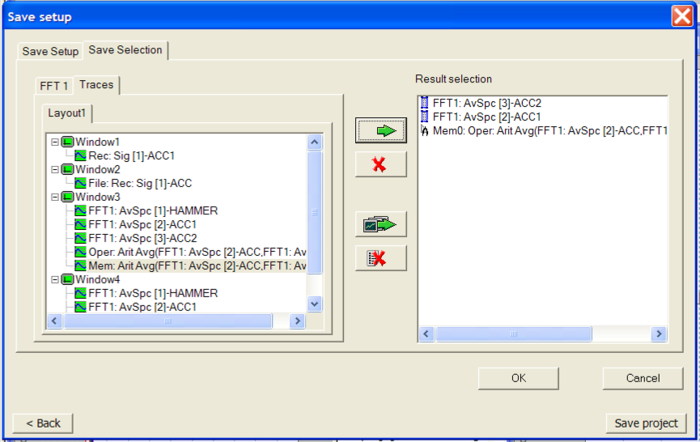Go to result group
Online mode

Post-analysis mode


|
Post-analysis to online: This button is used to switch from Online mode to Post-analysis mode.
|

|
Select signal: Opens the Select signal dialog to select the signal to be post-analyzed.
|

|
Select tracks: Opens the Inputs table showing the inputs definition of the signal to be post-analyzed.
|
Measurement group

Note that another Run/Pause/Stop button is always available in the status bar (bottom left)

|
Run: (CTRL+R) This button controls the general analysis and recording start. The plug-ins with connected channels/tracks will start their process once the run is activated.
Note: The monitor and the Time Domain Analysis (in free run mode) process is continuous; it do not depends on the run status.
Note: the trigger/start status of the plug-ins may block their process, waiting for an event.""
Warning: Pressing the run button during an analysis leads to reset all current analyses, restarting all averages from 0. The analyzed data will be lost.
|

|
Pause: Suspend or un-suspend the current analysis.
Note: If the recorder is running, it starts / finishes a record.
|

|
Stop: (CTRL+S) Stops all the current analyses and recording. After requesting a stop, the plug-ins finish their current block. When all the plug-ins have switched to Stop the analyzer switches to the Stopped status
Note: The analyzed results and recorded signal are saved when the analyzer switch to stop. This is the default behavior. It may be changed from the user preferences.
|
Save group


|
Save measurement: Save the result of the last measurement. This button is available when:
- There is at least one result selected in the save selection,
- The measurement is stopped,
- The result exists.
|

|
Save option: Define the way the results and signals are saved.
Save measurement
Save option
Define the way the results and signals are saved. It opens the Save setup dialog which contains 2 tabs.
Save setup tab

- Base name: The name the new measurement will have. A suffix is automatically added to the name if the specified name is already in use.
- Names from sequence: Select this option to link the measurement name to the corresponding sequence fields of the sequence currently in use.
See also "Sequence" topic from Chapter 5: Reports & Tools.
- Native format: Determines whether the measurement should be saved in OR3x format. If not selected, the new measurement will not appear in the project manager.
- Export format: Used to export the new measurement in an external format. A folder must be specified to receive the converted result.
See more details about the export formats in the "Export" topic from the "Chapter 7: User preferences".
- Auto-increment: Used to insure the new measurement has a unique name.
| Number
|
Adds a number to the Base name. The first available increment is used
|
| Date
|
Adds date information to the Base name. The date format is dd-mm-yyyy hh’mm’ss" or mm-dd-yy hh’mm’ss according to the regional settings of the PC
|
- Save option: This option determines the way in which the measurement will be created when the analyzer stops
| Do not save
|
No measurement will be created. The only way to save the results selected is to perform the Save Result command manually
|
| In default measurement
|
The measurement is created with the name "Default measurement". If a measurement with this name already exists, it is overwritten.
|
| With name confirmation
|
A dialog box will be displayed when the analyzer stops. It will suggest a name using a Base name and an auto increment choice.
|
| Without name confirmation
|
The measurement is created with a name automatically generated from the Base name and the auto increment choice.
|
- Default keyword: Used to choose the keyword that will be associated with the new measurement. Refer to the preference section for more information.
- Saved Results
- Current Analysis result: Results obtained from an acquisition.
- End of acquisition: open automatically a dialog box to save the results when the analyzer stops.
- Manually: allow to save the results manually.
- Working results: Results obtained after an operation based on already saved analysis results, for example a result calculated with an operator.
These results can be only saved manually.
Save selection tab

Results provided by the plug-ins
- Result selection: List of results provided by the plug-in analyzer selected. Multiple plug-ins may be selected if all results selected are compatible (which means that they can be displayed in the same result window).
- Channel selection: List of plug-in analyzer channels connected, available for the result selected.
- Operation: in the top combo-box, list of weighting that can be applied to results selected. In the middle combo-box, list of derivation/integration operations which can be applied. In the bottom combo-box, list of display units.
- Reference / X: List of plug-in analyzer channels connected. This can be the reference. Available for results that require a reference only (cross-spectrum, for example).
- Tracked order: List of tracked orders on channel selected. Available if result selected is an order result.
- Traces
List of traces available in the project coming from current analysis results and working results.
|
Setup group

|
|
Load setup: Opens the Load setup dialog, which allows loading setups from Models, Measurements and Projects or creating setups for online or post-analysis.
|
|
|
Save as model: Enables to save the current setup as a Model.
|
|
|
Active model: Displays the name of the loaded Model. This Model will remain active until a Reset setup is applied or another setup is loaded.
|
|
|
Reset: Closes the active Model and set all parameters to the default values.
|
Data group


|
Attachment: Enables to quickly identify if files (reports, pictures, videos....) are attached to the current project. Note: if the "Default project" is active, the Attachment button is greyed.

|
The Attachment folder of the current project is empty or does not exist.
|

|
File(s) are located in the Attachment folder of the current project.
|
|

|
Filter projects: Opens the Filter Project dialog, which enables selecting the projects to be visible in the Project manager.
|
Disk group

|
|
Record: Displays and enables selecting where the recording is performed (analyzer's disk or computer disk) or to stop temporarily the recording (off).
|
|
|
Used space: Gives a visual overview of the space available on the disk.
|
|
|
Download: Opens the Mobi-Disk manager dialog, which lists the signals available on the analyzer's disk and enables selecting the signals to be downloaded on the pc.
|
User
 User: This button allows selecting the current user. Note: changing from one user to another one will reset the current NVGate analysis configuration to the default one defined by the new user.
User: This button allows selecting the current user. Note: changing from one user to another one will reset the current NVGate analysis configuration to the default one defined by the new user.
User: This button allows selecting the current user. Note: changing from one user to another one will reset the current NVGate analysis configuration to the default one defined by the new user.











